2011 MERCEDES-BENZ SLS stop start
[x] Cancel search: stop startPage 381 of 436
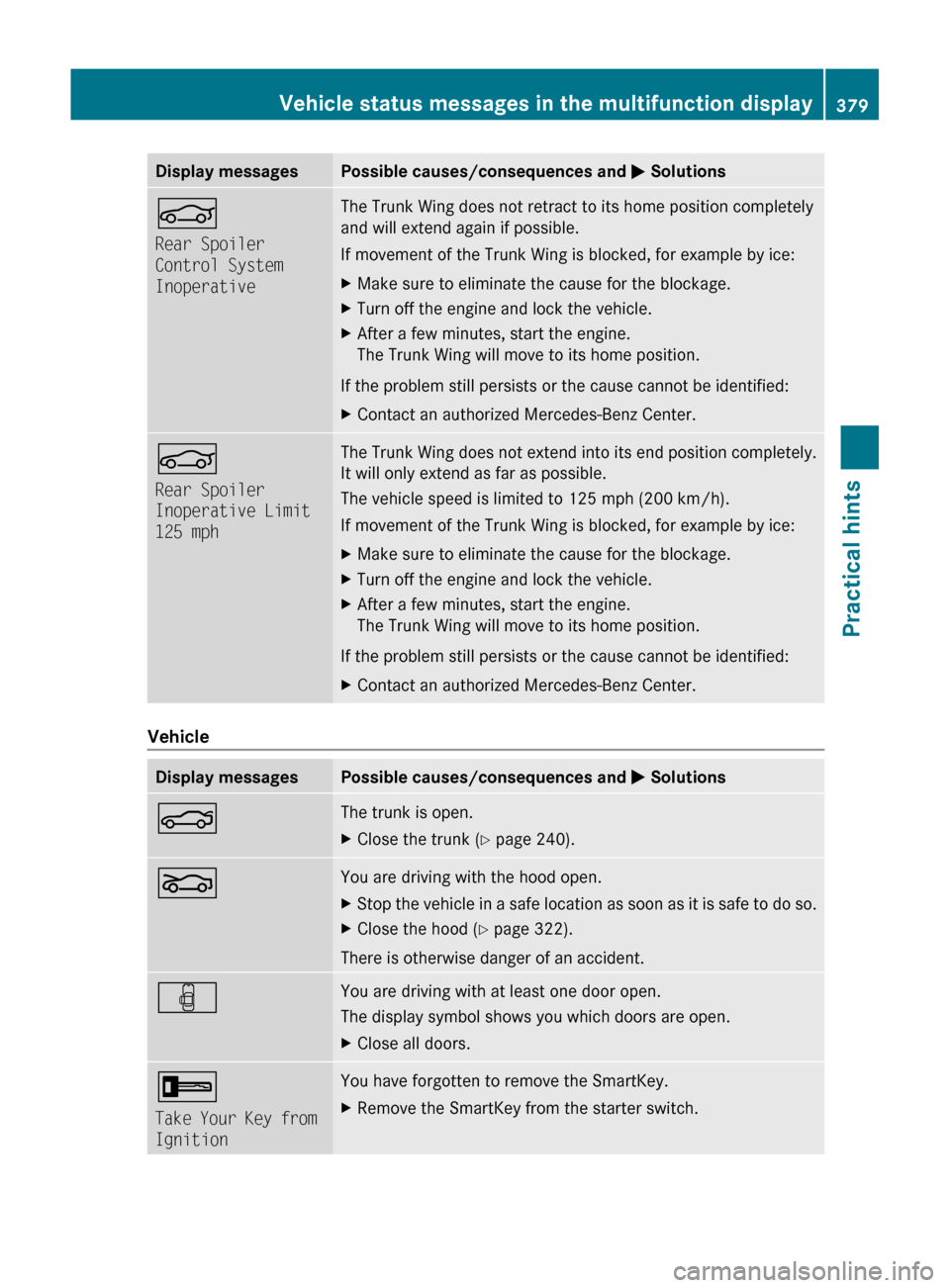
Display messagesPossible causes/consequences and M SolutionsÑ
Rear Spoiler
Control System
InoperativeThe Trunk Wing does not retract to its home position completely
and will extend again if possible.
If movement of the Trunk Wing is blocked, for example by ice:XMake sure to eliminate the cause for the blockage.XTurn off the engine and lock the vehicle.XAfter a few minutes, start the engine.
The Trunk Wing will move to its home position.
If the problem still persists or the cause cannot be identified:
XContact an authorized Mercedes-Benz Center.Ñ
Rear Spoiler
Inoperative Limit
125 mphThe Trunk Wing does not extend into its end position completely.
It will only extend as far as possible.
The vehicle speed is limited to 125 mph (200 km/h).
If movement of the Trunk Wing is blocked, for example by ice:XMake sure to eliminate the cause for the blockage.XTurn off the engine and lock the vehicle.XAfter a few minutes, start the engine.
The Trunk Wing will move to its home position.
If the problem still persists or the cause cannot be identified:
XContact an authorized Mercedes-Benz Center.
Vehicle
Display messagesPossible causes/consequences and M SolutionsNThe trunk is open. XClose the trunk ( Y page 240).LYou are driving with the hood open. XStop the vehicle in a safe location as soon as it is safe to do so.XClose the hood ( Y page 322).
There is otherwise danger of an accident.
´You are driving with at least one door open.
The display symbol shows you which doors are open.XClose all doors.+
Take Your Key from
IgnitionYou have forgotten to remove the SmartKey. XRemove the SmartKey from the starter switch.Vehicle status messages in the multifunction display379Practical hintsBA 197 USA, CA Edition A 2011; 1; 27, en-UShereepeVersion: 3.0.3.52010-03-24T15:31:10+01:00 - Seite 379Z
Page 382 of 436
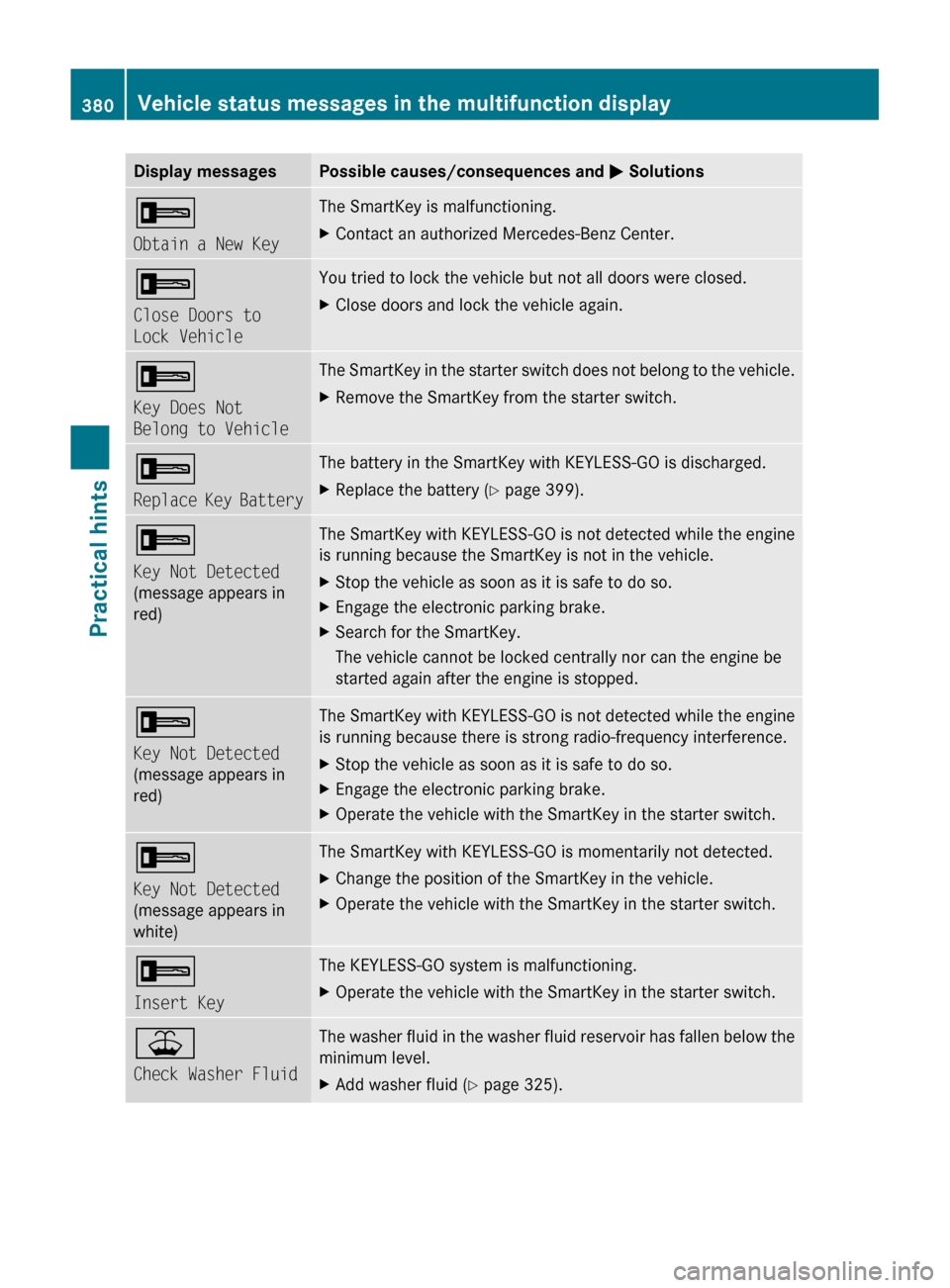
Display messagesPossible causes/consequences and M Solutions+
Obtain a New KeyThe SmartKey is malfunctioning.XContact an authorized Mercedes-Benz Center.+
Close Doors to
Lock VehicleYou tried to lock the vehicle but not all doors were closed.XClose doors and lock the vehicle again.+
Key Does Not
Belong to VehicleThe SmartKey in the starter switch does not belong to the vehicle.XRemove the SmartKey from the starter switch.+
Replace Key BatteryThe battery in the SmartKey with KEYLESS-GO is discharged.XReplace the battery ( Y page 399).+
Key Not Detected
(message appears in
red)The SmartKey with KEYLESS-GO is not detected while the engine
is running because the SmartKey is not in the vehicle.XStop the vehicle as soon as it is safe to do so.XEngage the electronic parking brake.XSearch for the SmartKey.
The vehicle cannot be locked centrally nor can the engine be
started again after the engine is stopped.+
Key Not Detected
(message appears in
red)The SmartKey with KEYLESS-GO is not detected while the engine
is running because there is strong radio-frequency interference.XStop the vehicle as soon as it is safe to do so.XEngage the electronic parking brake.XOperate the vehicle with the SmartKey in the starter switch.+
Key Not Detected
(message appears in
white)The SmartKey with KEYLESS-GO is momentarily not detected.XChange the position of the SmartKey in the vehicle.XOperate the vehicle with the SmartKey in the starter switch.+
Insert KeyThe KEYLESS-GO system is malfunctioning.XOperate the vehicle with the SmartKey in the starter switch.¥
Check Washer FluidThe washer fluid in the washer fluid reservoir has fallen below the
minimum level. XAdd washer fluid ( Y page 325).380Vehicle status messages in the multifunction displayPractical hints
BA 197 USA, CA Edition A 2011; 1; 27, en-UShereepeVersion: 3.0.3.52010-03-24T15:31:10+01:00 - Seite 380
Page 383 of 436

EngineDisplay messagesPossible causes/consequences and M Solutions+
Check Coolant
Level See
Operator's ManualThe coolant level is too low. XAdd coolant ( Y page 324).XIf you have to add coolant frequently, have the cooling system
checked at an authorized Mercedes-Benz Center.GWarning!
Do not spill antifreeze on hot engine parts. Antifreeze contains ethylene glycol which may burn
if it comes into contact with hot engine parts. You could be seriously burned.
! Do not ignore the low engine coolant level warning. Extended driving with the message
and symbol displayed may cause serious engine damage not covered by the Mercedes-Benz
Limited Warranty.
Do not drive without sufficient amount of coolant in the cooling system. The engine will
overheat causing major engine damage.
Display messagesPossible causes/consequences and M Solutions?
Coolant Level Low
Stop Vehicle Turn
Engine OffThe coolant is too hot.XStop the vehicle immediately as soon as it is safe to do so.XTurn off the engine immediately.XEngage the electronic parking brake.XOnly start the engine again after the message disappears. You
could otherwise damage the engine.XObserve the coolant temperature in the multifunction display.XIf the temperature rises again: Contact an authorized Mercedes-
Benz Center immediately.
During severe operation conditions and stop-and-go city traffic,
the coolant temperature may rise close to 248‡ (120†).
GWarning!
Driving when your engine is overheated can cause some fluids which may have leaked into the
engine compartment to catch fire. You could be seriously burned.
Steam from an overheated engine can cause serious burns which can occur just by opening the
engine hood. Stay away from the engine if you see or hear steam coming from it.
Stop the vehicle in a safe location away from other traffic. Turn off the engine, get out of the
vehicle and do not stand near the vehicle until the engine has cooled down.
! The engine should not be operated with the coolant temperature above 248‡ (120†).
Doing so may cause serious damage which is not covered by the Mercedes-Benz Limited
Warranty.
Vehicle status messages in the multifunction display381Practical hintsBA 197 USA, CA Edition A 2011; 1; 27, en-UShereepeVersion: 3.0.3.52010-03-24T15:31:10+01:00 - Seite 381Z
Page 388 of 436

Display messagesPossible causes/consequences and M Solutionsb
Auto Lamp Function
InoperativeThe light sensor is malfunctioning. The headlamps come on
automatically. XContact an authorized Mercedes-Benz Center as soon as
possible.
To switch off the headlamps (U.S. vehicles only):
XSwitch off the daytime running lamp mode in the control system
( Y page 284).XSwitch off the headlamps using the exterior lamp switch
( Y page 250).b
Check Left Low Beam
or
Check Right Low
BeamThe left or right low-beam lamp is malfunctioning. XContact an authorized Mercedes-Benz Center as soon as
possible.b
Switch Off LightsYou have removed the SmartKey with KEYLESS-GO from the
vehicle and left the headlamps on or removed the SmartKey from
the starter switch, opened the driver’s door and left the headlamps
on.XTurn the exterior lamp switch to c (Y page 250).b
Check Left Tail
and Brake Lamps
or
Check Right Tail
and Brake LampsThe left or right tail lamp/brake lamp is malfunctioning. This
message will only appear if all LEDs have stopped working.XContact an authorized Mercedes-Benz Center as soon as
possible.b
Check Rear Left
Turn Signal
or
Check Rear Right
Turn SignalThe left or right rear turn signal lamp is malfunctioning.XContact an authorized Mercedes-Benz Center as soon as
possible.386Vehicle status messages in the multifunction displayPractical hints
BA 197 USA, CA Edition A 2011; 1; 27, en-UShereepeVersion: 3.0.3.52010-03-24T15:31:10+01:00 - Seite 386
Page 393 of 436
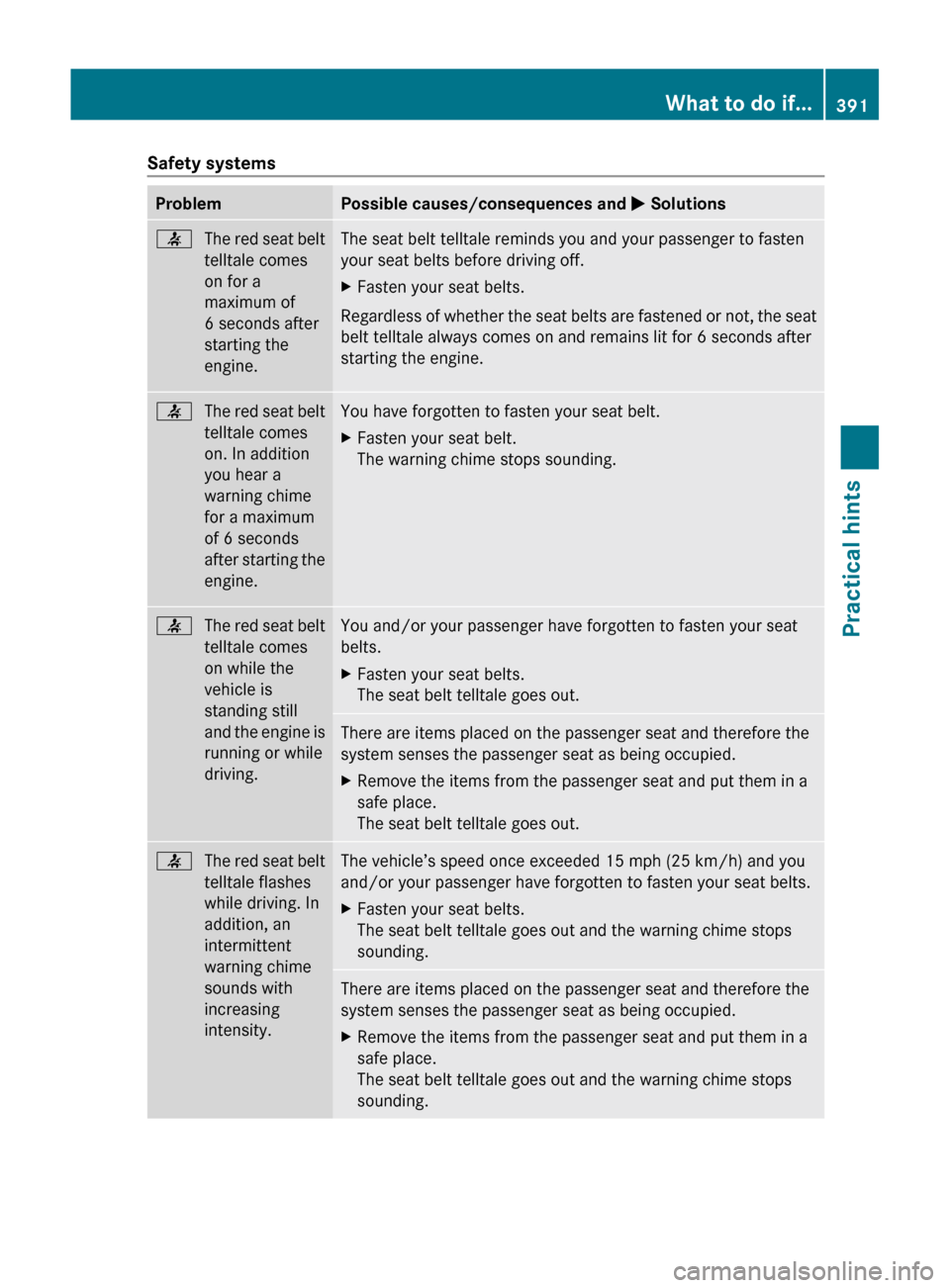
Safety systemsProblemPossible causes/consequences and M Solutions7The red seat belt
telltale comes
on for a
maximum of
6 seconds after
starting the
engine. The seat belt telltale reminds you and your passenger to fasten
your seat belts before driving off.XFasten your seat belts.
Regardless of whether the seat belts are fastened or not, the seat
belt telltale always comes on and remains lit for 6 seconds after
starting the engine.
7The red seat belt
telltale comes
on. In addition
you hear a
warning chime
for a maximum
of 6 seconds
after starting the
engine.You have forgotten to fasten your seat belt.XFasten your seat belt.
The warning chime stops sounding.7The red seat belt
telltale comes
on while the
vehicle is
standing still
and the engine is
running or while
driving.You and/or your passenger have forgotten to fasten your seat
belts.XFasten your seat belts.
The seat belt telltale goes out.There are items placed on the passenger seat and therefore the
system senses the passenger seat as being occupied.XRemove the items from the passenger seat and put them in a
safe place.
The seat belt telltale goes out.7The red seat belt
telltale flashes
while driving. In
addition, an
intermittent
warning chime
sounds with
increasing
intensity.The vehicle’s speed once exceeded 15 mph (25 km/h) and you
and/or your passenger have forgotten to fasten your seat belts.XFasten your seat belts.
The seat belt telltale goes out and the warning chime stops
sounding.There are items placed on the passenger seat and therefore the
system senses the passenger seat as being occupied.XRemove the items from the passenger seat and put them in a
safe place.
The seat belt telltale goes out and the warning chime stops
sounding.What to do if...391Practical hintsBA 197 USA, CA Edition A 2011; 1; 27, en-UShereepeVersion: 3.0.3.52010-03-24T15:31:10+01:00 - Seite 391Z
Page 398 of 436
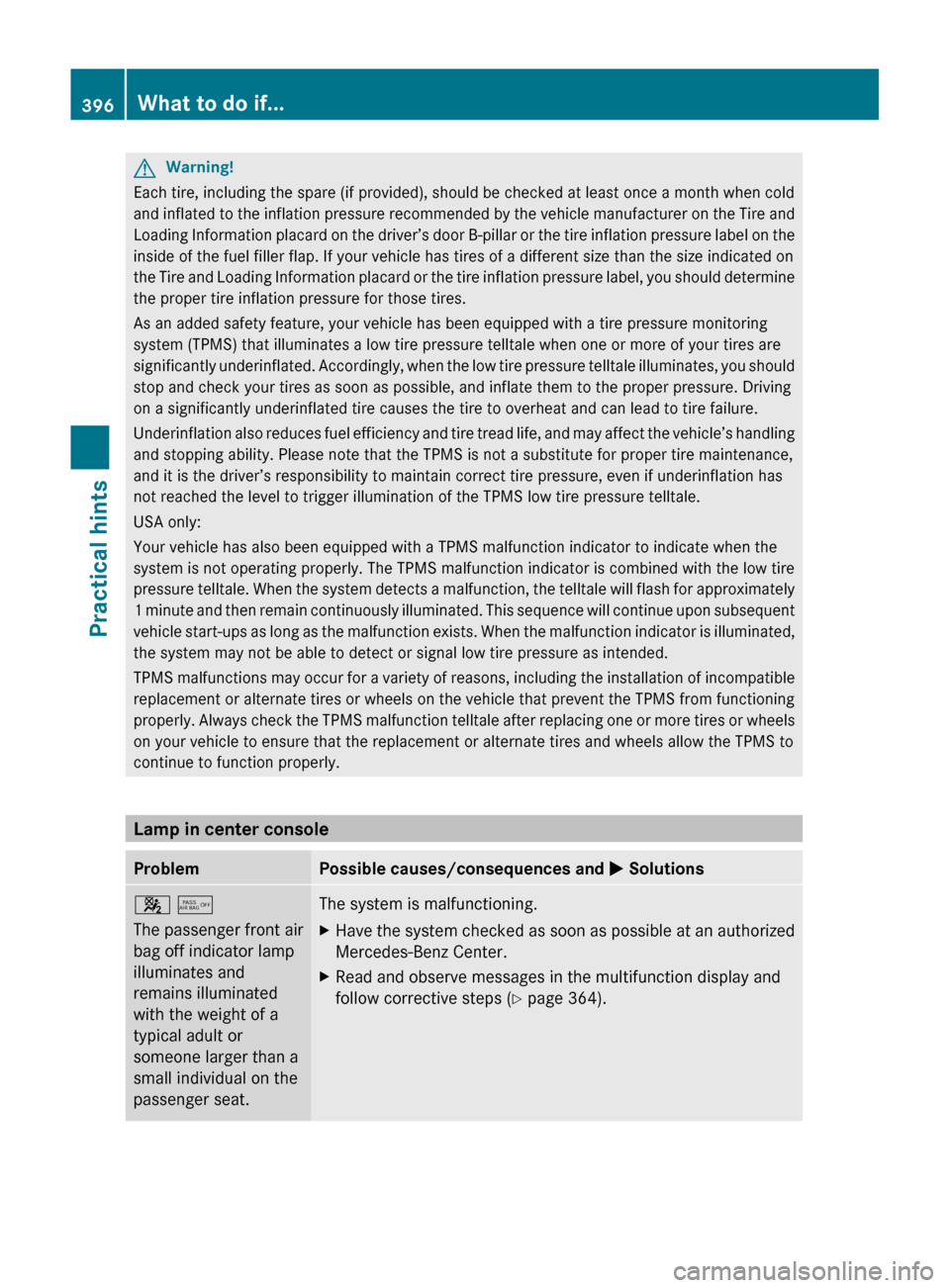
GWarning!
Each tire, including the spare (if provided), should be checked at least once a month when cold
and inflated to the inflation pressure recommended by the vehicle manufacturer on the Tire and
Loading Information placard on the driver’s door B-pillar or the tire inflation pressure label on the
inside of the fuel filler flap. If your vehicle has tires of a different size than the size indicated on
the Tire and Loading Information placard or the tire inflation pressure label, you should determine
the proper tire inflation pressure for those tires.
As an added safety feature, your vehicle has been equipped with a tire pressure monitoring
system (TPMS) that illuminates a low tire pressure telltale when one or more of your tires are
significantly underinflated. Accordingly, when the low tire pressure telltale illuminates, you should
stop and check your tires as soon as possible, and inflate them to the proper pressure. Driving
on a significantly underinflated tire causes the tire to overheat and can lead to tire failure.
Underinflation also reduces fuel efficiency and tire tread life, and may affect the vehicle’s handling
and stopping ability. Please note that the TPMS is not a substitute for proper tire maintenance,
and it is the driver’s responsibility to maintain correct tire pressure, even if underinflation has
not reached the level to trigger illumination of the TPMS low tire pressure telltale.
USA only:
Your vehicle has also been equipped with a TPMS malfunction indicator to indicate when the
system is not operating properly. The TPMS malfunction indicator is combined with the low tire
pressure telltale. When the system detects a malfunction, the telltale will flash for approximately
1 minute and then remain continuously illuminated. This sequence will continue upon subsequent
vehicle start-ups as long as the malfunction exists. When the malfunction indicator is illuminated,
the system may not be able to detect or signal low tire pressure as intended.
TPMS malfunctions may occur for a variety of reasons, including the installation of incompatible
replacement or alternate tires or wheels on the vehicle that prevent the TPMS from functioning
properly. Always check the TPMS malfunction telltale after replacing one or more tires or wheels
on your vehicle to ensure that the replacement or alternate tires and wheels allow the TPMS to
continue to function properly.
Lamp in center console
ProblemPossible causes/consequences and M Solutions4 5
The passenger front air
bag off indicator lamp
illuminates and
remains illuminated
with the weight of a
typical adult or
someone larger than a
small individual on the
passenger seat. The system is malfunctioning.XHave the system checked as soon as possible at an authorized
Mercedes-Benz Center.XRead and observe messages in the multifunction display and
follow corrective steps ( Y page 364).396What to do if...Practical hints
BA 197 USA, CA Edition A 2011; 1; 27, en-UShereepeVersion: 3.0.3.52010-03-24T15:31:10+01:00 - Seite 396
Page 403 of 436

GWarning!
Wiper blades are components that are subject
to wear and tear. Replace the wiper blades
twice a year, preferably in the spring and fall.
Otherwise the windshield will not be wiped
properly. As a result, you may not be able to
observe surrounding traffic conditions and
could cause an accident.
! To avoid damage to the hood, the wiper
arms should only be folded forward when
in the vertical position.
! Never open the hood when a wiper arm is
folded forward.
Hold on to the wiper when folding a wiper
arm back. If released, the force of the
impact from the tensioning spring could
crack the windshield.
Do not allow a wiper arm to contact the
windshield glass without a wiper blade
inserted.
Mercedes-Benz recommends that you have
this work carried out at an authorized
Mercedes-Benz Center.
Placing wiper arms in vertical position
:Wiper arms in vertical positionXMake sure the hood is fully closed.XMake sure the vehicle’s on-board
electronics have status 1.
XTurn the combination switch to wiper
setting °.
XPress the KEYLESS-GO start/stop button
repeatedly until the windshield wipers
start.
XPress the KEYLESS-GO start/stop button
when the wiper arms are in vertical
position :.
Removing wiper blades
! Do not pull on the wiper blade inserts.
They could tear.
XFold the wiper arm forward until it snaps
into place.
XTurn the wiper blade at a right angle to
wiper arm.
XSlide the wiper blade sideways out of the
retainer.
Installing wiper blades
XSlide the wiper blade onto the wiper arm
until it locks in place.
XRotate the wiper blade into a position
parallel to the wiper arm.
XFold the wiper arm backward to rest on the
windshield.
Make sure you hold on to the wiper when
folding the wiper arm back.
! Make sure the wiper blades are installed
properly. Improperly installed wiper blades
may cause windshield damage.
Replacing wiper blades401Practical hintsBA 197 USA, CA Edition A 2011; 1; 27, en-UShereepeVersion: 3.0.3.52010-03-24T15:31:10+01:00 - Seite 401Z
Page 405 of 436
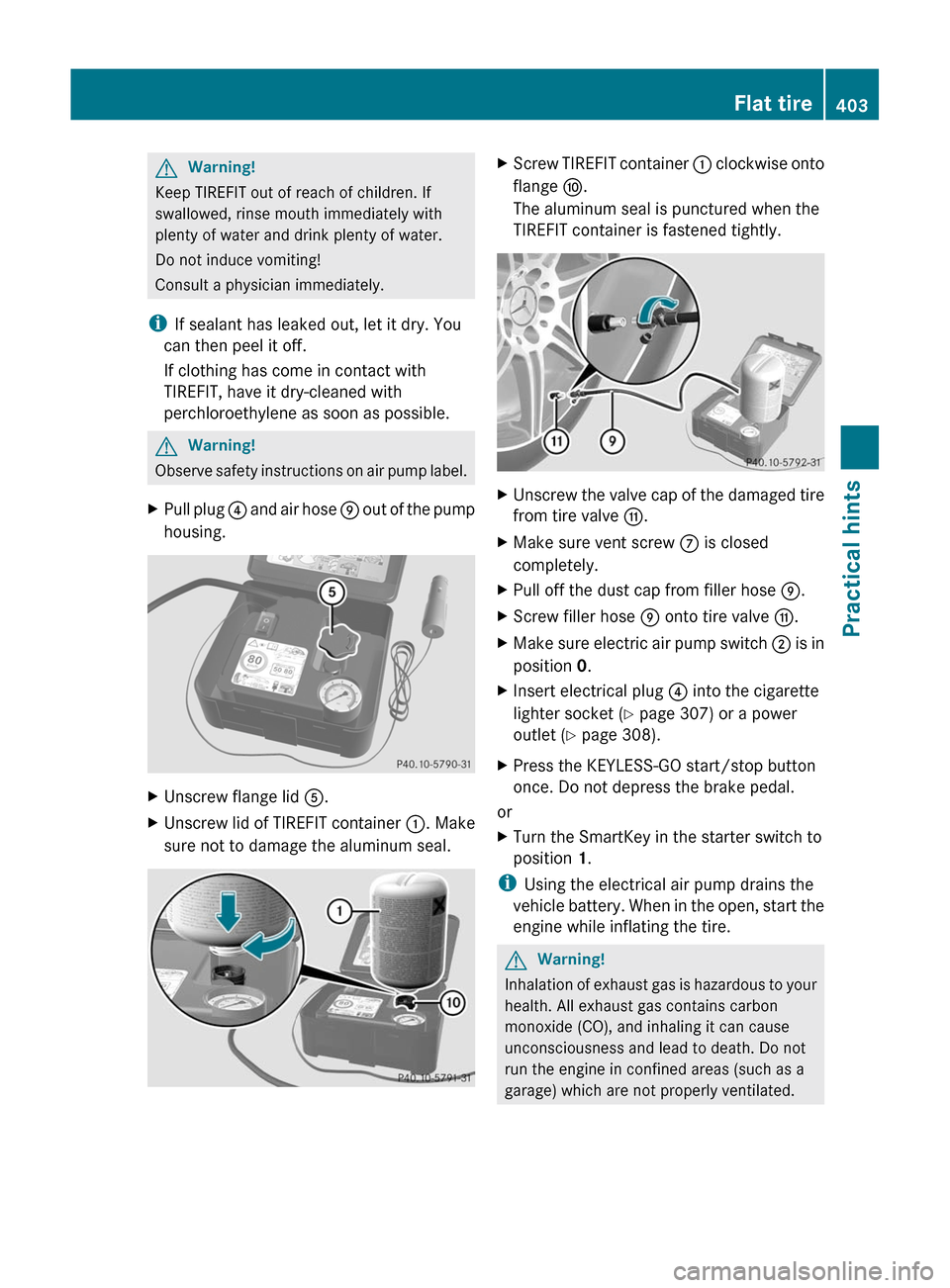
GWarning!
Keep TIREFIT out of reach of children. If
swallowed, rinse mouth immediately with
plenty of water and drink plenty of water.
Do not induce vomiting!
Consult a physician immediately.
iIf sealant has leaked out, let it dry. You
can then peel it off.
If clothing has come in contact with
TIREFIT, have it dry-cleaned with
perchloroethylene as soon as possible.
GWarning!
Observe safety instructions on air pump label.
XPull plug ? and air hose E out of the pump
housing.
XUnscrew flange lid A.XUnscrew lid of TIREFIT container :. Make
sure not to damage the aluminum seal.
XScrew TIREFIT container : clockwise onto
flange F.
The aluminum seal is punctured when the
TIREFIT container is fastened tightly.
XUnscrew the valve cap of the damaged tire
from tire valve G.
XMake sure vent screw C is closed
completely.
XPull off the dust cap from filler hose E.XScrew filler hose E onto tire valve G.XMake sure electric air pump switch ; is in
position 0.
XInsert electrical plug ? into the cigarette
lighter socket (Y page 307) or a power
outlet (Y page 308).
XPress the KEYLESS-GO start/stop button
once. Do not depress the brake pedal.
or
XTurn the SmartKey in the starter switch to
position 1.
iUsing the electrical air pump drains the
vehicle battery. When in the open, start the
engine while inflating the tire.
GWarning!
Inhalation of exhaust gas is hazardous to your
health. All exhaust gas contains carbon
monoxide (CO), and inhaling it can cause
unconsciousness and lead to death. Do not
run the engine in confined areas (such as a
garage) which are not properly ventilated.
Flat tire403Practical hintsBA 197 USA, CA Edition A 2011; 1; 27, en-UShereepeVersion: 3.0.3.52010-03-24T15:31:10+01:00 - Seite 403Z